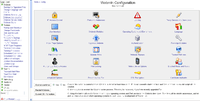Webmin
|
Version 1.420 working on a production server | |
| Developer(s) | Jamie Cameron and the Webmin community[1] |
|---|---|
| Initial release | October 5, 1997 (version 0.1) |
| Stable release | 1.801 (May 26, 2016) [±] |
| Written in | Perl |
| Operating system | "The best supported systems at the moment are Solaris, Linux (Red Hat in particular) and FreeBSD" and other supported OSes[2] |
| Available in | English, Catalan, Dutch, German, partial translations[3] |
| Type | Control panel |
| License | BSD-like license |
| Website |
www |
Webmin is a web-based system configuration tool for Unix-like systems, although recent versions can also be installed and run on Windows.[4] With it, it is possible to configure operating system internals, such as users, disk quotas, services or configuration files, as well as modify and control open source apps, such as the Apache HTTP Server, PHP or MySQL.[5][6]
General description
Webmin is largely based on Perl, running as its own process and web server. It defaults to TCP port 10000 for communicating, and can be configured to use SSL if OpenSSL is installed with additional required Perl Modules.
It is built around modules, which have an interface to the configuration files and the Webmin server. This makes it easy to add new functionality. Due to Webmin's modular design, it is possible for anyone who is interested to write plugins for desktop configuration.
Webmin also allows for controlling many machines through a single interface, or seamless login on other webmin hosts on the same subnet or LAN.
Webmin is primarily coded by Australian Jamie Cameron[1] and released under the BSD license.
Inclusion in distributions
While Webmin was included in the official repositories of the major GNU/Linux distributions Debian and Ubuntu, it was removed from those because Webmin is not compatible with the way that those distros' packages handle configuration files, and caused unexpected issues with people's systems.[7]
Related software
Webmin can be expanded by installing modules, which can be custom made. Aside from this, there are two other major projects that extend the functionality of webmin:[6]
- Usermin presents and controls a subset of the features available in Webmin, such as webmail and other user-level tasks, rather than administrator-level tasks.
- Virtualmin, which is a web hosting control panel. Out of the box, Virtualmin enables users to host websites under domains. This gives the server admin and the end user an easy to use interface for managing their websites.
Webmin released Minecraft Server Module 1.0 in January 2013, and version 1.1 in March 2013. The module presents a very basic GUI for server administration. While server management application Multicraft may be more sleekly designed, the free version of Multicraft is limited to 10 simultaneous players. The Webmin Minecraft server is free and open source with no limitations on simultaneous players.
See also
References
- 1 2 "Introduction to Webmin". Webmin. Retrieved 11 February 2007.
- ↑ "Supported Systems". Webmin. Retrieved 11 February 2007.
- ↑ "Supported Languages". Webmin.
- ↑ "Installing on Windows". Webmin.
- ↑ Federico Kereki (2008-04-01). "Graphic Administration with Webmin". Linux Journal. Retrieved 2014-04-08.
- 1 2 Shawn Powers (July 2012). "Webmin—the Sysadmin Gateway Drug". The Open-Source Classroom. Porky.linuxjournal.com. Retrieved 2014-04-08.
- ↑ Ubuntu documentation Webmin
